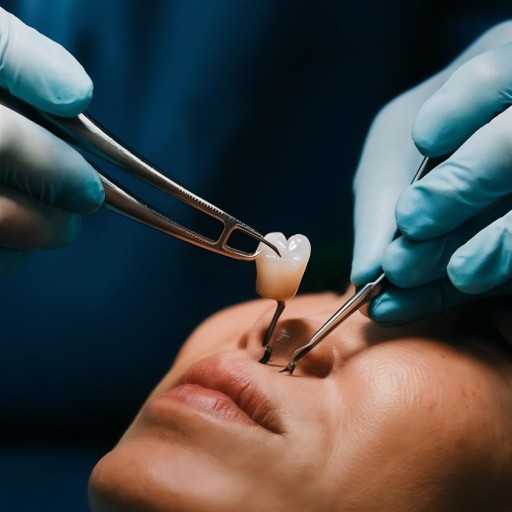Tooth Extraction
2 results foundTooth Extraction: Things You Need to Know Toward a Healthier Smile
Extraction refers to the process of removing a tooth from its socket. It is one of the common dental procedures performed for various reasons. While generally considered a last resort, removing a tooth can relieve pain and pressure, stop infection, and correct overcrowding and damage. Sometimes, whether due to serious decay, crowding, or damage, a tooth must be removed so the rest of your smile may be saved.
In this article, we are going to find out why the extraction of teeth is necessary, what process is involved in the procedure, and what one should expect before, during, and after the procedure. We will also look at possible risks and how to take care of your mouth afterward to ensure a smooth recovery.
Why Is Tooth Extraction Necessary?
It varies from purely cosmetic to health-related issues. The following are some of the major indications that could warrant an extraction, among others:
Advanced Tooth Decay: In case a tooth is seriously decayed and it is not possible to restore it with a filling or crown, removal could be the ideal option to avoid the risk of further infection.
Gum Disease: When periodontitis or advanced gum disease has loosened the teeth, sometimes it is too hard to save the teeth. It may need to be extracted to prevent further infection of the bone or other teeth.
Crowded Teeth: Sometimes teeth may need to be extracted when there isn't enough room in the mouth for all of the teeth to line up properly. This is often before orthodontic treatment.
Impacted Teeth: These are teeth that have not been able to emerge properly from the gums and may cause pain, infection, or damage neighboring teeth. These situations can include removal of wisdom teeth or even other teeth. Trauma: If the teeth have become seriously fractured or broken in some kind of accident, such teeth could be extracted if restoration is impossible. Infection: If an infection does not show improvement by antibiotic treatment or root canal therapy, it could require removing the tooth.
Sometimes, a dentist or an oral surgeon may recommend an extraction as a precautionary measure to prevent future oral health complications.
The Process of Tooth Extraction
Tooth extraction can broadly be classified into a number of steps. The procedure could either be performed by a general dentist or by an oral surgeon depending upon the complexity of the extraction.
1. Preparation
Consecutively, the dentist will do a thorough examination of the teeth and gums before the procedure; he might also X-ray the tooth to see in which position the tooth is situated and where its roots are. The dentist will also ask about your current and past health history to make out whether there is no contradiction to the procedure.
2. Anesthesia
He will inject a local anesthetic into the gum area around the tooth in order to ensure the procedure is painless. For the more complicated extractions, such as impacted wisdom teeth, sedation or general anesthesia may be administered.
3. Tooth Removal
Extraction: This is where the dentist or oral surgeon loosens up the tooth with a careful rocking action. If the tooth is impacted or coming in with several roots, the dentist may need to surgically cut the gum tissue or extract the tooth in sections.
4. Aftercare
After the tooth is removed, your dentist will clean the area and apply a gauze pad over the extraction site to help control bleeding. Sometimes, stitches are used to close the gum tissue.
Types of Tooth Extractions
Primarily, there exist two types of tooth extractions:
Simple Extraction: This is normally performed when the tooth can be seen within the mouth and extracted using forceps. It is normally done in cases when a tooth has fallen out or becomes badly decayed.
Surgical Extraction: When the tooth is broken, impacted, or not fully emerged from the gum, this becomes the more complex extraction. In this technique, the dentist or oral surgeon will make an incision in the gum to reach the tooth.
Which of the two procedures will be performed depends on the condition of the tooth and its positioning in the mouth.
What to Expect During the Procedure
Extraction of a tooth is, to some extent, a simple procedure; there are quite a number of things one may expect from such a procedure. Pain Management: There will be an administration of an anesthetic before the extraction to numb the area. If you are anxious, discuss the sedation options with your dentist. Duration: The duration usually takes about 20-40 minutes for a simple extraction, while the surgical might take longer, as the complexity in the extraction of the tooth may be involved.
Sense of Pressure: You should not feel any pain, only pressure when your dentist loosens your tooth and removes it.
Post-Surgical Pain: You will experience some discomfort or swelling around the extraction site once the anesthetic used has worn off. This is typical.
Recovery and Aftercare
After having your tooth extracted, aftercare methods are essential in aiding recovery. Here are some very helpful guidelines to manage the period after the extraction of your teeth:
Rest: It is relevant after the procedure to be able to rest and not indulge in strenuous activities for a couple of days. This helps minimize the complication risks. Pain Management: When the anesthesia starts to wear off, you might feel some pain or discomfort. While over-the-counter pain relievers such as ibuprofen may suffice, your dentist may also prescribe stronger pain medications if necessary.
Cold Packs: An ice pack can be placed against the outside of the cheek near the extraction site. This will help reduce the swelling and discomfort.
Avoid Lifting or Spitting: Avoid the use of straws, smoking, and spitting with force. All these actions can displace the blood clot in the socket and delay healing. It must be avoided for at least a period of 24 hours.
Follow-up Appointments: In some cases, your dentist may need you to return to the dental clinic after the extraction because of the difficulty of the surgery and also for stitch removal.
Possible Risks and Complications
Tooth extraction is generally a very safe procedure; however, there are some risks and complications associated with it:
Infection: There is always some small chance of infection following any surgical procedure, including the extraction of teeth. You can minimize this risk by rinsing the extraction site and following any aftercare instructions provided by your dentist.
Dry Socket: When a blood clot in the socket becomes dislodged or dissolves too quickly, the bone and nerves become exposed to air and food. Dry socket is often a painful condition that can delay your healing process.
Excessive Bleeding: Though a certain degree of bleeding following the extraction of a tooth is usual, heavy bleeding may be considered for medical attention.
Damage to the nerves: In very rare cases, there may be partial or permanent damage to one of the nerves involved in an extraction. This can affect sensation in your tongue, chin, or lip.
Severe pain, swelling, or any infection signs like fever or pus are things you must clear immediately with your dentist.
Alternatives to Tooth Extraction
Although it may sometimes be inevitable to extract the tooth, depending on the situation, here are some alternatives one could consider:
Root Canals: When the tooth is very decayed but not infected, treatment with a root canal may just salvage the tooth through elimination of the infected pulp and sealing of the tooth.
Crowns or Fillings: In the case of a mildly damaged tooth, a dental crown or filling can easily restore the use and appearance of that particular tooth without it being extracted.
He will discuss all options with you and come to a decision on which is best in your particular case.
Conclusion: Extraction of Teeth for a Healthy Smile
Tooth extraction does sound daunting, but it is usually one of the very important procedures in maintaining the health and longevity of your smile. Be it the removal of a severely damaged tooth or making room for orthodontic treatment, good aftercare and regular dental check-ups will get you up and running in no time, also preventing further oral health issues. Always consult with your dentist or oral surgeon to understand the best options for your individual needs. With proper care, one is able to restore and maintain a healthy, confident smile.


